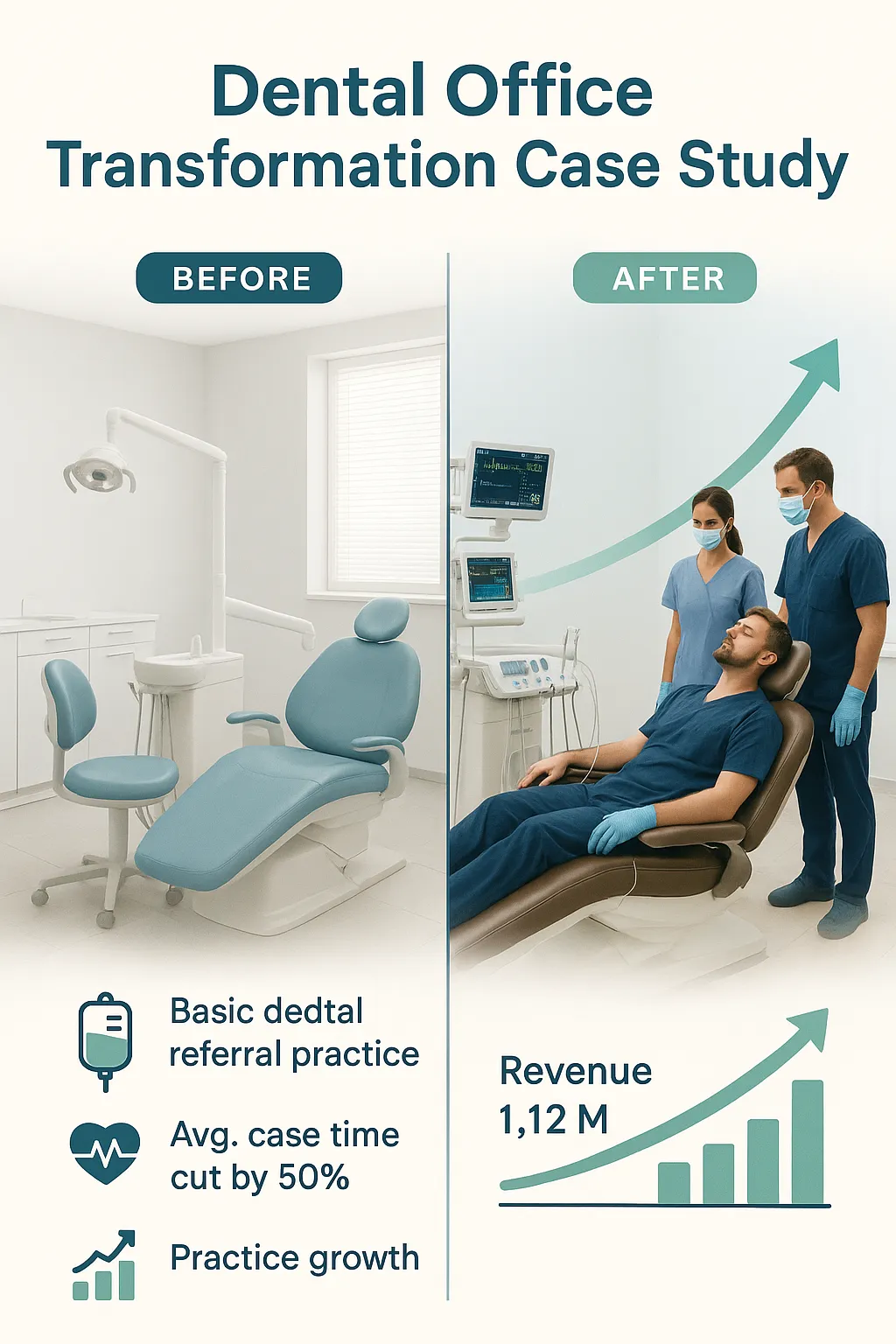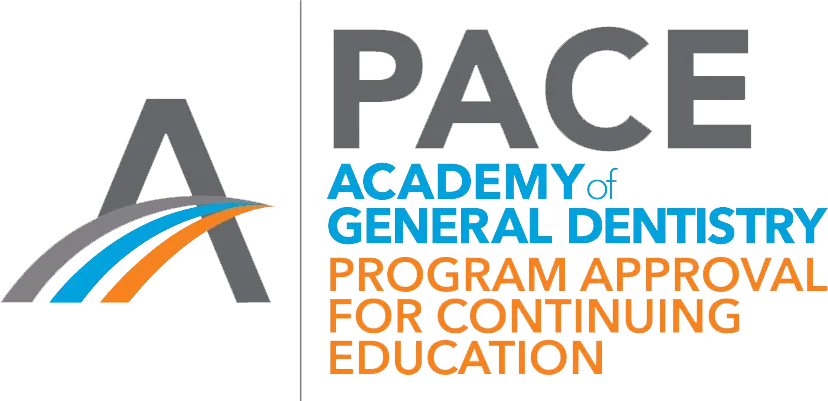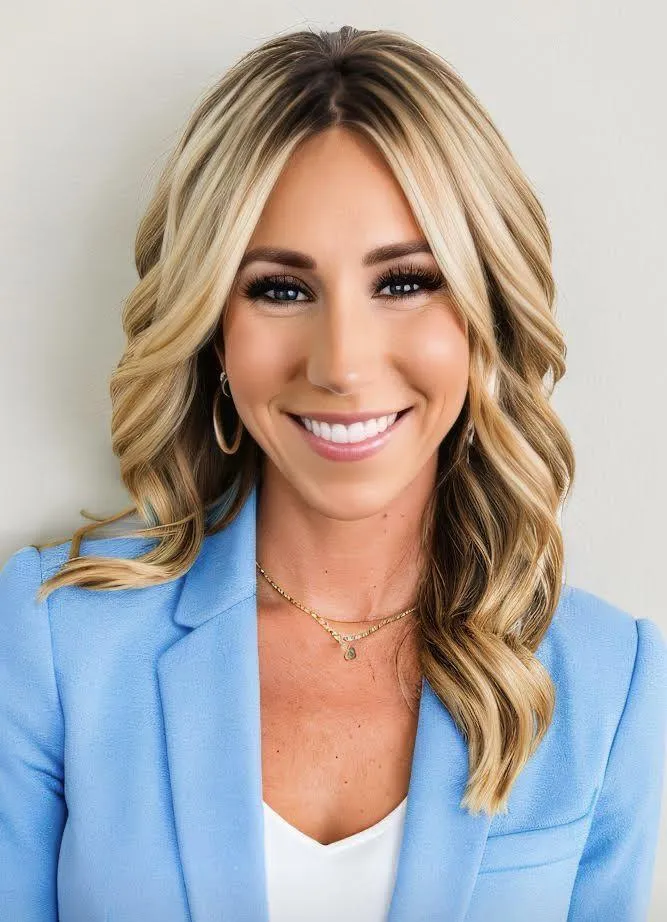
How Sedation Services Can Transform Your Dental Practice Revenue: Lessons from a $50K/Month Success Story
A comprehensive guide to building profitable sedation services in your dental practice, featuring insights from Dr. Heath Hendrickson's transformation of Western Surgical & Sedation
The Untapped Revenue Opportunity in Dental Sedation
Why This Matters for Your Practice:
75% of patients experience dental anxiety
Average sedation case value: $600-800 vs. $280 for standard procedures
Growing demand for comfort-focused dental care
Limited competition in most markets
Higher patient loyalty and referral rates
Get Your Free Practice Growth Consultation → Book Now | Call: (385) 899-2486
What You'll Learn in This Guide
The Hidden Revenue Opportunity in Patient Anxiety
Patient anxiety represents one of the largest untapped revenue opportunities in dentistry today. While most practices view anxious patients as challenging cases to be managed, forward-thinking practitioners are discovering how to transform anxiety into a profitable specialty service.
Dr. Heath Hendrickson, owner of Western Surgical & Sedation in Utah, exemplifies this transformation. His practice has grown from modest referral-based revenue to generating over $50,000 monthly through strategic sedation specialization.
The Market Reality
Patient Demand Statistics:
75% of dental patients experience some level of anxiety
25% avoid necessary procedures due to fear
67% willing to travel further for comfort-focused care
91% interested in same-day sedation consultations
74% willing to pay out-of-pocket for sedation services
Current Market Gaps:
Most practices offer limited sedation options
Complex procedures often require hospital referrals
Long wait times for sedation services
Limited emergency sedation availability
Few practices positioned as sedation specialists
Financial Opportunity:
Average sedation case value: $600-800 vs. $280 for standard procedures
Higher patient retention rates (85% vs. 45%)
Premium pricing justification through specialized service
Multiple revenue streams from different sedation modalities
Recurring revenue from ongoing patient relationships
Common Revenue Challenges in Dental Practices
Before exploring sedation opportunities, it's important to understand why most dental practices struggle with revenue growth and how sedation services address these fundamental challenges.
Traditional Practice Limitations
Revenue Bottlenecks:
Dependence on insurance reimbursements
Commodity pricing for standard procedures
High competition in local markets
Limited differentiation from competitors
Inconsistent patient flow and scheduling gaps
Patient Experience Issues:
High anxiety levels affecting treatment completion
Longer appointment times due to patient discomfort
Frequent cancellations and no-shows
Limited options for anxious or phobic patients
Poor online reviews related to patient discomfort
Operational Challenges:
Underutilized chair time due to scheduling inefficiencies
Staff stress from managing difficult cases
Difficulty justifying premium pricing
Limited growth potential with existing services
High overhead with static revenue potential
The Sedation Solution
Sedation services address these challenges by:
Creating premium service offerings with higher case values
Reducing cancellations and improving appointment completion rates
Attracting patients willing to pay for comfort and convenience
Establishing clear differentiation in the marketplace
Building a reputation as the practice for difficult cases
Building a Profitable Sedation Program
Creating a successful sedation program requires careful planning, proper training, and strategic implementation. Here's the comprehensive framework that practices like Western Surgical & Sedation use to build profitable sedation services.
Phase 1: Market Assessment and Planning
Understanding Your Market: Start by analyzing your current patient base and local market to identify sedation opportunities:
Survey existing patients about anxiety levels and sedation preferences
Research local competition and their sedation offerings
Analyze referral patterns for anxious or difficult cases
Evaluate insurance coverage for sedation services in your area
Assess your facility's capability for sedation service expansion
Revenue Potential Analysis: Calculate the financial opportunity by examining:
Current average case values vs. potential sedation case values
Number of anxious patients currently treated or referred out
Market size for sedation services in your geographic area
Pricing opportunities for different sedation modalities
Potential for attracting new patients seeking sedation options
Phase 2: Service Development and Training
Sedation Service Menu:
1. Nitrous Oxide (Laughing Gas)
Entry-level sedation option
Ideal for mild to moderate anxiety
Quick onset and recovery
Typical pricing: $150-250 per procedure
Minimal additional training required
2. Oral Conscious Sedation
Moderate sedation using prescribed medications
Suitable for longer procedures and higher anxiety
Cost-effective option for patients
Typical pricing: $350-500 per procedure
Requires additional certification and monitoring
3. IV Moderate Sedation
Deepest level of outpatient sedation
Ideal for complex procedures and severe anxiety
Premium service offering
Typical pricing: $600-900 per procedure
Requires advanced training and equipment
4. Combination Protocols
Customized approaches using multiple modalities
Tailored to individual patient needs
Maximum comfort and safety
Typical pricing: $450-700 per procedure
Requires expertise in multiple sedation methods
Phase 3: Infrastructure and Equipment
Essential Equipment Investments:
Basic Monitoring Equipment:
Pulse oximetry for oxygen saturation monitoring
Blood pressure monitoring systems
Capnography for respiratory monitoring
Automated external defibrillator (AED)
Emergency medication kit
Advanced Sedation Equipment:
IV sedation delivery systems
Advanced patient monitoring systems
Recovery area furnishings and equipment
Emergency oxygen delivery systems
Specialized dental equipment for sedated patients
Facility Modifications:
Comfortable consultation rooms for sedation planning
Private recovery areas with appropriate amenities
Enhanced privacy and soundproofing
Calming environmental elements (lighting, aromatherapy)
Emergency access and evacuation procedures
Phase 4: Staff Training and Certification
Required Certifications:
Basic Life Support (BLS) for all staff
Advanced Cardiac Life Support (ACLS) for sedation providers
Pediatric Advanced Life Support (PALS) if treating children
State-specific sedation permits and licenses
Continuing education requirements for maintenance
Training Components:
Sedation pharmacology and patient selection
Monitoring protocols and emergency procedures
Patient communication and anxiety management
Insurance coordination and billing procedures
Quality assurance and documentation requirements
Implementation Strategy and Timeline
Successfully launching sedation services requires a phased approach that allows for gradual skill development, system refinement, and market education.
Months 1-2: Foundation and Planning
Assessment and Planning:
Complete market research and competitive analysis
Develop business plan and financial projections
Secure necessary permits and licenses
Design facility modifications and equipment procurement
Create staff training timeline and certification plan
Initial Training:
Begin staff education on sedation principles
Complete basic life support certifications
Research sedation training programs and continuing education
Develop patient communication and consultation protocols
Create emergency response procedures
Months 3-4: Training and Certification
Advanced Education:
Complete sedation certification programs
Obtain necessary state permits and licenses
Practice sedation procedures under supervision
Develop patient selection and screening protocols
Create documentation and record-keeping systems
System Development:
Install monitoring equipment and safety systems
Complete facility modifications for sedation services
Develop patient education materials and consent forms
Create scheduling protocols for sedation appointments
Establish emergency response and evacuation procedures
Months 5-6: Soft Launch and Refinement
Service Launch:
Begin with basic sedation options (nitrous oxide)
Treat carefully selected patients with mild anxiety
Monitor outcomes and refine protocols
Gather patient feedback and adjust procedures
Train staff on patient flow and recovery procedures
Marketing and Education:
Educate referring doctors about new sedation services
Create patient education materials and website content
Develop marketing materials highlighting sedation expertise
Begin community education about sedation dentistry
Establish relationships with medical professionals
Months 7-12: Expansion and Growth
Service Expansion:
Add oral conscious sedation services
Implement IV sedation for appropriate cases
Develop specialty protocols for complex patients
Expand to emergency and urgent sedation services
Consider combination sedation approaches
Market Development:
Increase marketing efforts and community outreach
Develop referral programs with other healthcare providers
Create patient testimonials and success stories
Participate in professional organizations and conferences
Establish reputation as regional sedation specialist
Expected Financial Returns and Growth
Understanding the financial potential of sedation services helps practices make informed decisions about investment and implementation timelines.
Revenue Growth Projections
Typical Growth Timeline:
Months 1-6: 25-50% revenue increase through basic sedation services
Months 7-12: 75-150% revenue increase with full service implementation
Months 13-18: 200-400% revenue increase with market establishment
Year 2+: Continued growth through reputation and referral development
Revenue by Service Type:
Nitrous Oxide: $3,000-8,000 monthly potential
Oral Sedation: $8,000-20,000 monthly potential
IV Sedation: $15,000-35,000 monthly potential
Emergency Services: $2,000-5,000 monthly potential
Consultation Services: $1,000-3,000 monthly potential
Investment and ROI Analysis
Typical Investment Requirements:
Equipment and facility modifications: $40,000-75,000
Training and certification: $8,000-15,000
Marketing and practice development: $10,000-20,000
Working capital and operational expenses: $15,000-25,000
Total Initial Investment: $75,000-135,000
Return on Investment Timeline:
Break-even point: Typically 6-10 months
Full ROI achievement: Usually within 12-15 months
Long-term profitability: 45-65% profit margins on sedation services
Practice value increase: 2-4x multiplier due to specialized services
Factors Affecting Financial Success
Market Factors:
Local competition and sedation service availability
Demographics and insurance coverage in your area
Referral relationships and professional networks
Community awareness of sedation dentistry benefits
Practice Factors:
Quality of implementation and training
Marketing effectiveness and practice positioning
Patient experience and satisfaction levels
Operational efficiency and cost management
Critical Success Factors
Based on analysis of successful sedation practices like Western Surgical & Sedation, several key factors determine the success or failure of sedation service implementation.
1. Patient Safety and Clinical Excellence
Non-Negotiable Standards:
Comprehensive training and ongoing education for all staff
State-of-the-art monitoring equipment and emergency protocols
Rigorous patient screening and selection procedures
Detailed documentation and quality assurance programs
Regular safety audits and continuous improvement initiatives
Safety Outcomes: Successful practices maintain excellent safety records with zero adverse events, which builds patient confidence and referral relationships.
2. Patient Experience and Communication
Experience Elements:
Comfortable, spa-like environment design
Comprehensive patient education and preparation
Personalized sedation planning and consultation
Excellent communication before, during, and after procedures
Family involvement and updates during treatment
Communication Strategy:
Pre-procedure preparation calls and education
Day-of-procedure anxiety management and reassurance
Real-time family updates during longer procedures
Post-procedure follow-up and recovery support
Long-term relationship building and maintenance
3. Strategic Marketing and Positioning
Positioning Strategy:
Establish practice as sedation specialists rather than general practitioners
Focus marketing on comfort, safety, and expertise
Develop educational content about sedation benefits and safety
Create patient testimonials and success stories
Build reputation through professional relationships and community involvement
Marketing Tactics:
Search engine optimization for sedation-related keywords
Educational seminars for referring doctors and patients
Social media content focusing on patient comfort and outcomes
Community outreach and professional organization participation
Patient referral programs and incentives
4. Operational Excellence and Systems
System Requirements:
Streamlined scheduling and patient flow management
Automated patient communication and reminder systems
Efficient insurance coordination and billing procedures
Quality assurance and outcome tracking systems
Continuous improvement culture and feedback loops
Operational Benefits:
Higher appointment completion rates (95%+ vs. 80-85% typical)
Improved patient satisfaction scores (95%+ vs. 80-85% typical)
Increased case acceptance rates (85%+ vs. 60-70% typical)
Enhanced staff satisfaction and retention
Improved practice efficiency and profitability
Frequently Asked Questions
Q: How long does it take to see significant revenue increases from sedation services? A: Most practices begin seeing meaningful revenue growth within 3-6 months of implementing sedation services. Significant increases (100%+ revenue growth) typically occur within 8-12 months as word-of-mouth referrals accelerate and systems become more efficient.
Q: What's the total investment required to add sedation services? A: Initial investments typically range from $75,000-135,000, including equipment, training, facility modifications, and marketing. This investment is usually recovered within 12-15 months through increased revenue and higher case values.
Q: How do you ensure patient safety with sedation services? A: Patient safety requires comprehensive training, proper equipment, rigorous protocols, and ongoing education. Successful practices maintain emergency procedures, use advanced monitoring equipment, and follow strict patient screening guidelines to achieve excellent safety records.
Q: What role does insurance play in sedation service profitability? A: Insurance coverage varies by carrier and medical necessity. Many sedation services are covered when medically necessary, and patients are often willing to pay out-of-pocket for comfort. Successful practices employ dedicated staff to maximize insurance coverage while offering financing options.
Q: How do referring doctors respond to expanded sedation services? A: Referring doctors are typically very positive about sedation services because it provides solutions for their most challenging patients. Practices should provide education and communication to help referring doctors understand and explain sedation options to patients.
Q: What ongoing training and certification is required? A: Sedation providers must maintain current certifications in CPR, ACLS, and state-specific sedation permits. Continuing education requirements vary by state but typically require 10-20 hours annually. Staff should also receive ongoing training in emergency procedures and patient care.
Q: How scalable is the sedation service model? A: The sedation model is highly scalable with proper planning and implementation. Practices can start with basic services and gradually expand to more advanced techniques. Success depends on maintaining focus on safety, patient experience, and clinical excellence.
Q: What marketing strategies work best for sedation services? A: Educational marketing is most effective, including patient testimonials, referring doctor education, and community outreach. Online presence optimization for anxiety and sedation-related searches is also crucial. Word-of-mouth referrals become increasingly important as reputation grows.
Getting Started: Your Action Plan
If you're considering adding sedation services to your practice, here's a practical action plan to begin your transformation:
Immediate Next Steps (Next 30 Days)
Assessment Phase:
[ ] Survey your current patients about anxiety levels and sedation interest
[ ] Research local competition and sedation service availability
[ ] Evaluate your facility's capability for sedation service expansion
[ ] Contact sedation training programs for certification information
[ ] Calculate potential ROI using conservative growth projections
Planning Phase:
[ ] Develop a timeline for implementation with realistic milestones
[ ] Create a budget for equipment, training, and facility modifications
[ ] Identify staff members for sedation training and certification
[ ] Research state licensing requirements and permit procedures
[ ] Design patient education materials about sedation options
90-Day Implementation Plan
Month 1: Foundation Building
Begin staff education and basic certification programs
Research equipment vendors and financing options
Develop patient consultation and screening protocols
Create marketing materials highlighting comfort and safety
Establish relationships with sedation training programs
Month 2: Training and Development
Complete sedation certification programs and state permits
Install basic monitoring equipment and safety systems
Develop emergency procedures and staff training protocols
Create patient education and consent materials
Begin referring doctor education and outreach programs
Month 3: Service Launch
Launch basic sedation services with carefully selected patients
Implement patient feedback collection and analysis systems
Begin marketing campaigns focusing on sedation expertise
Monitor outcomes and refine protocols based on results
Plan expansion to additional sedation modalities
Long-Term Growth Strategy (6-18 Months)
Service Expansion:
Add advanced sedation options as expertise develops
Develop specialty protocols for complex cases and special needs patients
Create emergency sedation availability for referring practices
Consider offering training and mentorship to other practices
Establish regional reputation as sedation specialist
Market Development:
Build comprehensive referral network with medical professionals
Develop community education programs about sedation dentistry
Create patient success story campaigns and testimonials
Participate in professional organizations and continuing education
Mentor other practices considering sedation service implementation
Transform Your Practice with Sedation Services
The opportunity to transform your dental practice through sedation services has never been greater. With 75% of patients experiencing dental anxiety and limited competition in most markets, practices that successfully implement sedation services can expect dramatic revenue growth and improved patient satisfaction.
Dr. Heath Hendrickson's success with Western Surgical & Sedation demonstrates what's possible when practices focus on patient comfort and clinical excellence. His transformation from a traditional practice to a $50,000+ monthly sedation specialist provides a roadmap that other practices can follow.
The key insight: Patients desperately want comfortable dental experiences and are willing to seek out and pay premium prices for practices that provide them.
Ready to Get Started?
If you're serious about transforming your practice through sedation services, the team at Western Surgical & Sedation offers consultation and mentorship to help you implement these strategies successfully.
What's Included in Your Consultation:
Comprehensive practice assessment and sedation opportunity analysis
Customized implementation plan with realistic timelines and budgets
Training recommendations and certification guidance
Marketing strategy development for sedation services
Ongoing support and mentorship throughout implementation
📞 Call Today: (385) 899-2486
💻 Schedule Online: Book a Free Consultation
📧 Email: [email protected]
Limited Time: Schedule your consultation this month and receive a complete "Sedation Service Implementation Guide" with templates, checklists, and protocols valued at $2,500.
About Western Surgical & Sedation
Western Surgical & Sedation, owned and operated by Dr. Heath Hendrickson, has become Utah's premier destination for comfortable dental procedures. The practice specializes in anxiety-free dental care using the latest sedation techniques and technology, serving patients throughout Utah and the surrounding region.
Our Mission: To eliminate dental anxiety and provide comfortable, safe surgical and sedation services that allow patients to receive the care they need without fear or discomfort.
Services: Comprehensive oral surgery, IV sedation, oral conscious sedation, nitrous oxide administration, emergency sedation services, and practice consultation for sedation service implementation.
Recognition: Regional leader in sedation dentistry, authorized training provider, and recipient of multiple patient care excellence awards.
Contact Information:
Phone: (385) 899-2486
Website: westernsurgicalandsedation.com
Email: [email protected]
This educational guide is based on real practice data and industry research. Individual practice results may vary based on market conditions, implementation quality, local competition, and other factors. Always consult with qualified professionals and regulatory bodies before implementing sedation services in your practice.




Facebook
Youtube
Instagram